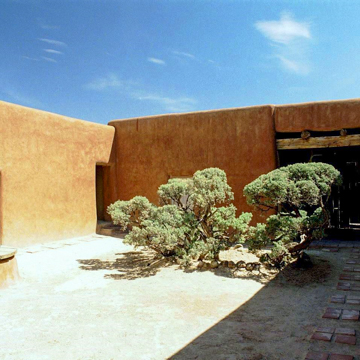From 1949 until two years before her death in 1986, Georgia O’Keeffe lived in this adobe house overlooking the Chama River valley, a high desert landscape that was featured in some of her most famous paintings. In collaboration with Maria Chabot, O’Keeffe restored and expanded the house to reflect her interests in nature, Modernism, and Japanese aesthetics. The property also became the place where visitors paid court and photographed O’Keeffe for the books and magazines that made her into a cultural icon. O’Keeffe’s house and studio both expressed her personal identity and represented her public persona as an artist who embodied the place in which she lived.
The original house of the Montoya family was a single file of rooms dating to c. 1734; this was extended by the Chavéz faimily in the mid-nineteenth century to enclose a courtyard. When O’Keeffe first visited Abiquiú in 1934, the adobe walls were in ruins, but she was captivated by the south side of the courtyard, writing later “That wall with a door in it was something I had to have.” In 1940, O’Keeffe bought a house at nearby Ghost Ranch, while she continued to try to buy the property in Abiquiú from the Archdiocese of Santa Fe. Her persistence paid off in 1945, when the Church agreed to sell; O’Keeffe paid $500 outright and completed the purchase with a $2,500 tax-deductible contribution.
From 1946 until 1949, she and Maria Chabot rebuilt and transformed the ruined house. O’Keeffe met Chabot in 1940, when the latter was managing the ranch of Mary Wheelwright in Alcalde. In the 1930s, Chabot had begun the Santa Fe Indian Market while serving as the Executive Secretary of the New Mexico Association for Indian Affairs (NMAIA), and had photographed and documented the material culture of the Native and Hispanic Southwest for the federal government’s Indian Arts and Crafts Board. In July 1946, Alfred Stieglitz died, and O’Keefe had to spend extended periods in New York settling her husband’s estate. From 1946 to 1949, Chabot sent regular reports on the rebuilding to O’Keeffe, soliciting her opinions and making suggestions on how to handle the project.
The house was modernized both practically and aesthetically. Plumbing and electricity were installed, and many of the earthen floors were covered with concrete and cork, or finished with boards. The heavy adobe walls were opened up with generous windows, and their planar masses were further simplified and emphasized by the elimination of two typical elements of the New Mexico vernacular: protruding vigas and a tall parapet. Heightening the modernist effect, the whitewashed interiors were fitted out with furniture by Charles and Ray Eames, Eero Saarinen, and Henry Bertoia; cushions by Alexander Girard accented the built-in benches while white slipcovers neutralized the upholstered furniture.
Chabot convinced O’Keeffe to turn the old stables and buggy house into a studio with windows looking across the Chama Valley. An enormous plate glass window takes up most of the north wall of the studio, while a corner window in O’Keeffe’s adjacent bedroom allows for vistas extending to north and east.
The minimalism of the house and studio were complemented by O’Keeffe’s interest in Japanese aesthetics, particularly her admiration for The Book of Tea by Okakura Kakuzō (an admiration shared with her teacher, Arthur Wesley Dow). What Okakura called “the simplicity and purism of the tea room” is evoked most directly in the central courtyard and an unrestored section of the house known as “the roofless room.” Voids open to the sky, each is given focus by a carefully placed arrangement of abstract sculpture, bones, stones, natural wood, and (in the courtyard) a single desert shrub that O’Keeffe pruned and shaped.
O’Keeffe’s house and studio also relate to her paintings. Objects that she painted were placed on display in and around the compound, and the door on the south side of the courtyard was the subject of thirty artworks painted between 1946 and 1960. On many levels, the house merged Georgia O’Keeffe’s life with her art, from its location in a landscape that inspired some of her most famous work, to its adobe walls fabricated from the earth that she brought to life in her paintings, to its fusing of indigenous traditions with Modernism and Japanese aesthetics. Over the three and a half decades that she lived there, the house itself became a work of art that encapsulated her persona and became a potent image of her mythic status.
Reservations for guided tours of the house and studio can be made through the Georgia O’Keefe Museum.
References
Burt, Sarah L. “O’Keeffe, Georgia, Home and Studio,” Rio Arriba County, New Mexico. National Historic Landmark Nomination Form, July 1, 1998. National Park Service, U.S. Department of the Interior, Washington, D.C.
Lynes, Barbara Buhler, and Agipita Judy Lopez. Georgia O’Keeffe and Her Houses: Ghost Ranch and Abiquiú. New York: Abrams, 2012.
Martin, Douglas. “Maria Chabot, 87, Dies; Began Indian Market and Was an O'Keeffe Associate.” New York Times, July 15, 2001.
Messinger, Lisa Mintz. Georgia O’Keeffe. New York: Thames and Hudson, 2001.
Okakura, Kakuzō. The Book of Tea. Rutland, VT: Charles E. Tuttle, 1956.
Patten, Christine Taylor. Miss O’Keeffe. Albuquerque: University of New Mexico Press, 1992.
Richardson, Bruce. Preface and Introduction to The Book of Tea by Okakura Kakuzo. Perryville, KY: Benjamin Press, 2011.
Wood, Margaret. Remembering Miss O’Keeffe: Stories from Abiquiú. With photographs by Myron Wood. Santa Fe: Museum of New Mexico Press, 2012.
Wood, Myron. O’Keeffe at Abiquiú. With text by Christine Taylor Patten. New York: Abrams, 1995.

